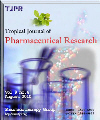
|
Tropical Journal of Pharmaceutical Research
Pharmacotherapy Group, Faculty of Pharmacy, University of Benin, Benin City, Nigeria
ISSN: 1596-5996
EISSN: 1596-5996
Vol. 11, No. 1, 2012, pp. 28-35
|
 Bioline Code: pr12004
Bioline Code: pr12004
Full paper language: English
Document type: Research Article
Document available free of charge
|
|
|
Tropical Journal of Pharmaceutical Research, Vol. 11, No. 1, 2012, pp. 28-35
| en |
Formulation of Sustained-Release Matrix Tablets Using Cross-linked Karaya gum
Reddy, Mahesh M; Reddy, Jagadeeswara D; Moin, Afrasim & Shivakumar, HG
Abstract
Purpose: To develop sustained release matrix tablets of diltiazem hydrochloride (DTZ) using modified karaya gum (MK).
Methods: MK was prepared by cross-linking karaya gum with tri-sodium tri-metaphosphate (STMP) which was used as a cross-linker. Matrix tablets of DTZ were prepared using varying ratios of unmodified karaya gum (K) and MK by direct compression. The matrix tablets were evaluated for pharmacotechnical properties and in vitro release, including release kinetics. The optimized formulation was compared with Dilzem SR which served as reference. MK and the formulations were also characterized by scanning electron microscopy (SEM), Fourier transform infra-red spectroscopy (FTIR) and differential scanning calorimetry (DSC).
Results: Tablets with MK showed higher mean dissolution time (MDT) and lower dissolution efficiency than those prepared with karaya gum. Drug release was by water uptake, diffusion and erosion mechanisms. Drug release from tablets formulated with unmodified K at the end of 10 h was 99.9 %, and while for MK tablets, it was 68.2 % at the end of 12h. MK sufficiently controlled drug release unlike K which exhibited poor sustained drug release. Formulation F6 compared well with the reference, Dilzem SR (p <0.05), in terms of release characteristics. Cumulative drug release at the end of 12 h for both test and reference formulations was approx. 85 %. SEM images of the tablets before and after dissolution showed some morphological differences on their tablet surfaces while FTIR and DSC thermogram studies confirmed that there was no chemical interaction between the drug and the polymers in MK formulation.
Conclusion: The results of the study demonstrate that modified karaya gum has good potentials for formulating suitable sustained-release matrix tablets of diltiazem.
Keywords
Karaya gum, Diltiazem hydrochloride, Tri-Sodium Tri-metaphosphate, Crosslinking, Matrix tablets, Sustained release
|
| |
© Copyright - 2012 Tropical Journal of Pharmaceutical Research
Alternative site location: http://www.tjpr.org
|
|
